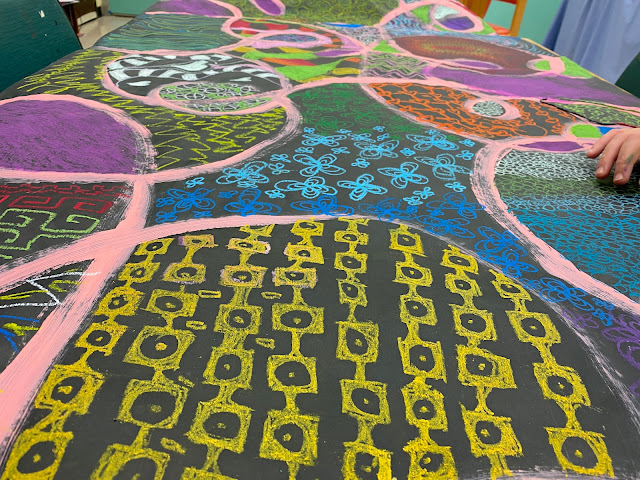The fact that we've been studying repetition, pattern, and unity made for a coherent and colorful body of work. We used some of our zentangle portraits for show posters and invitations, made commercials for the morning news, and cookies for the opening reception. Turn out was better than we'd seen in years and the students felt great about being able to put together a body of work in a short period of time.
Thursday, September 28, 2023
Fall Student Art Show
Textured Caulk Paintings
Monday, September 18, 2023
Analogous Rectilinear Cardboard Relief Art
Saturday, September 16, 2023
Zentangle Portraits
To build on our pattern lesson and give our doodles something to do, my students created what I call "zentangled portraits." They used a picture of themselves, a friend or a model in a magazine, cut out only the neck and face, following the hairline and collaged to a larger piece of paper.

Some images took on royal or saintly mantles as the background was broken up with halos, arches, and crowns, and those spaces were filled with repeated marks from black sharpies. Some kept encorporated colored paper, markers or colored pencil to add another layer of complexity.
Students who were blind, used Wixi Sticks to divide the space, and then stayed within each shape filling it marks such as stripes, O's or X's. I love the pattern-saturated surfaces of Gustav Klimt paintings and I love the way this assignment turned out.
Design Time: Zentangle Collaboration
Repetition is a Principle of Design, which is used to create pattern, textures, and rhythm in art. Some patterns have names: check board, basketweave, zig zag, polka dots, while others are waiting to be invented. It's good to break out of your doodle comfort zone which is surprisingly small for most visually impaired people and try to repeat marks that you haven't tried before.
My students created their own chart with a handful of different patterns before contributing to the larger group composition. Tables were covered with bulletin board paper and when students finished their own work, they could contribute to this group composition. It's fun to work together to learn and create.
Friday, September 15, 2023
Dog Relief Sculpture, Wall Art
DisneyPlus has show, Critter Fixers: Country Vets, which is filmed in Georgia not far from The Academy for the Blind. In fact, we had some students do some work-based-learning with them on a regular basis last school year, culminating in a school assembly Q&A session with the Critter Fixers stars, Dr. Hodges and Dr. Ferguson. Students were able to walk to different stations on campus, petting various animals and listening to their heartbeat through a stethoscope. It was a great day and we all looked forward to seeing the episode when it came out.
Months later, the show's producer came back and, during a tour of the school, stopped by the Art room and mentioned how nice it would be to have a piece of student artwork on a wall of Critter Fixers. Immediately, the parent mentor, who was giving the tour, mentioned Kirby, as a subject. Kirby is the school's emotional support dog. Minutes after they left, I started looking for pictures of the black Labrador Retriever. Students helped me pick a couple of my sketches, and then they traced the projections onto a large piece of paper to use as patterns. I used the patterns to cut out layers of cardboard, glued together to make a thick structure.

















